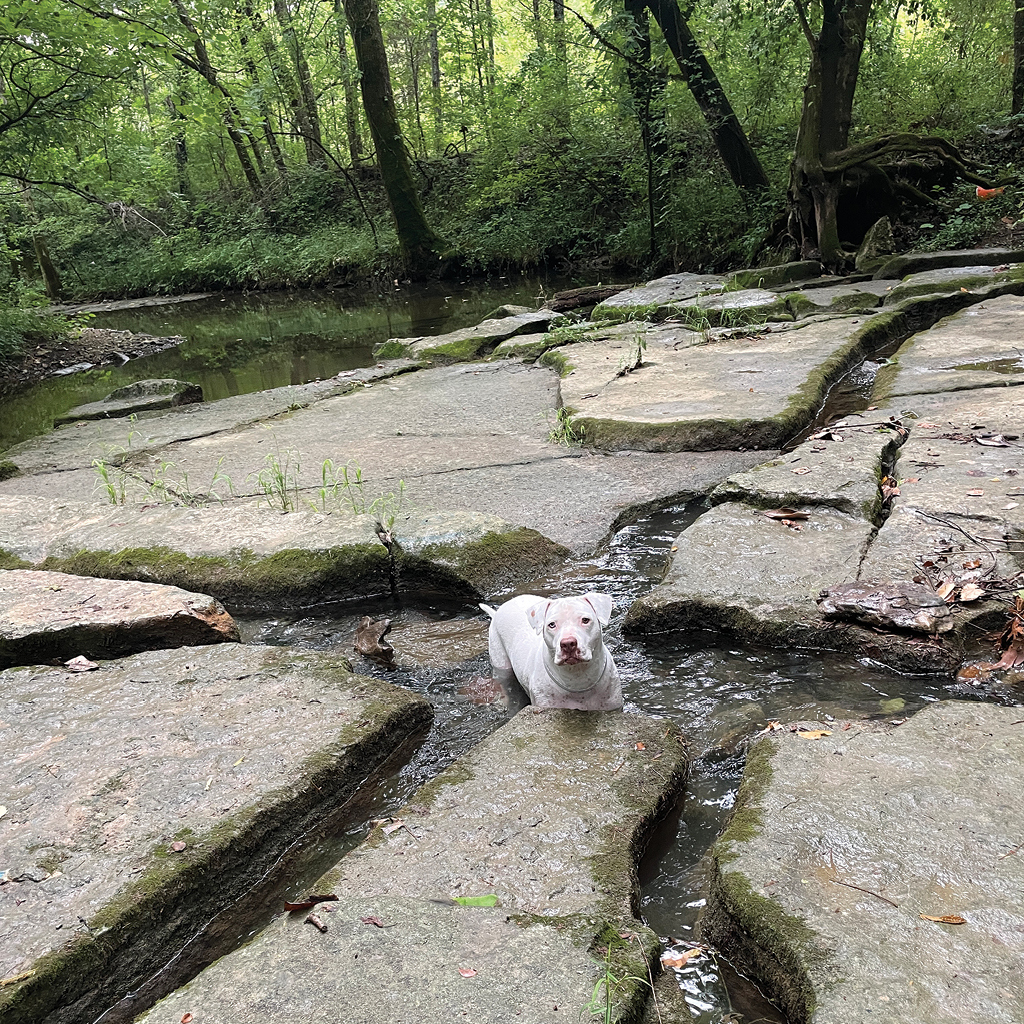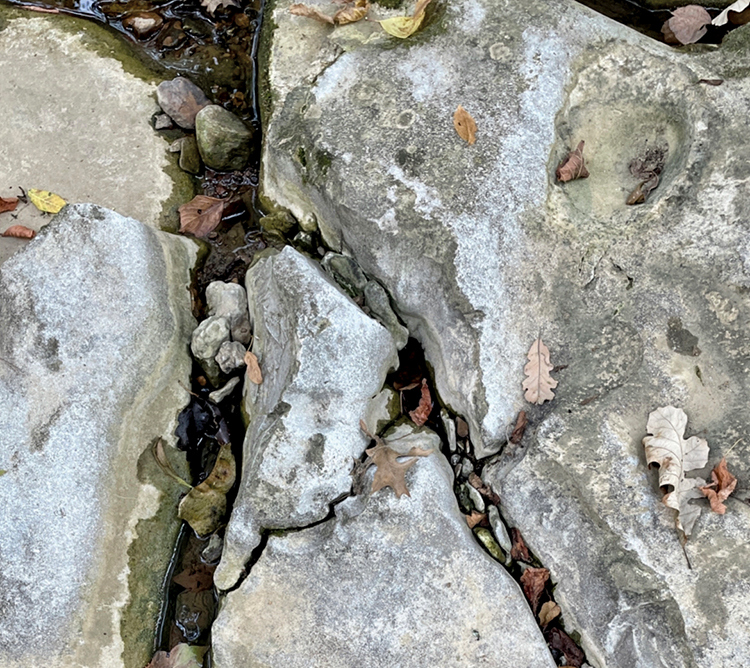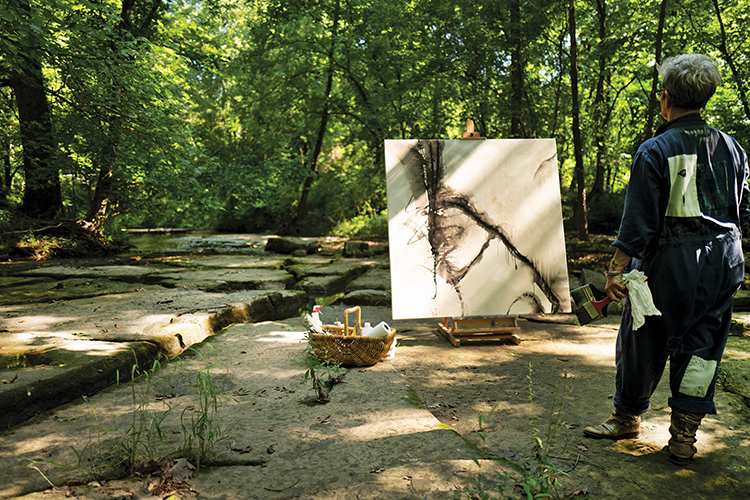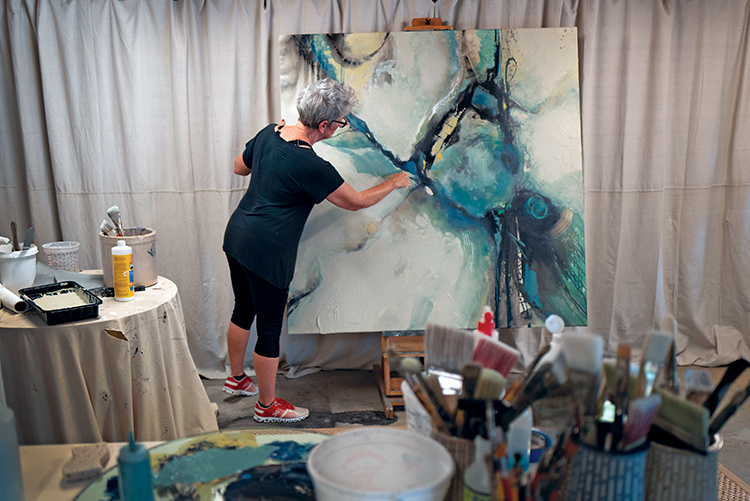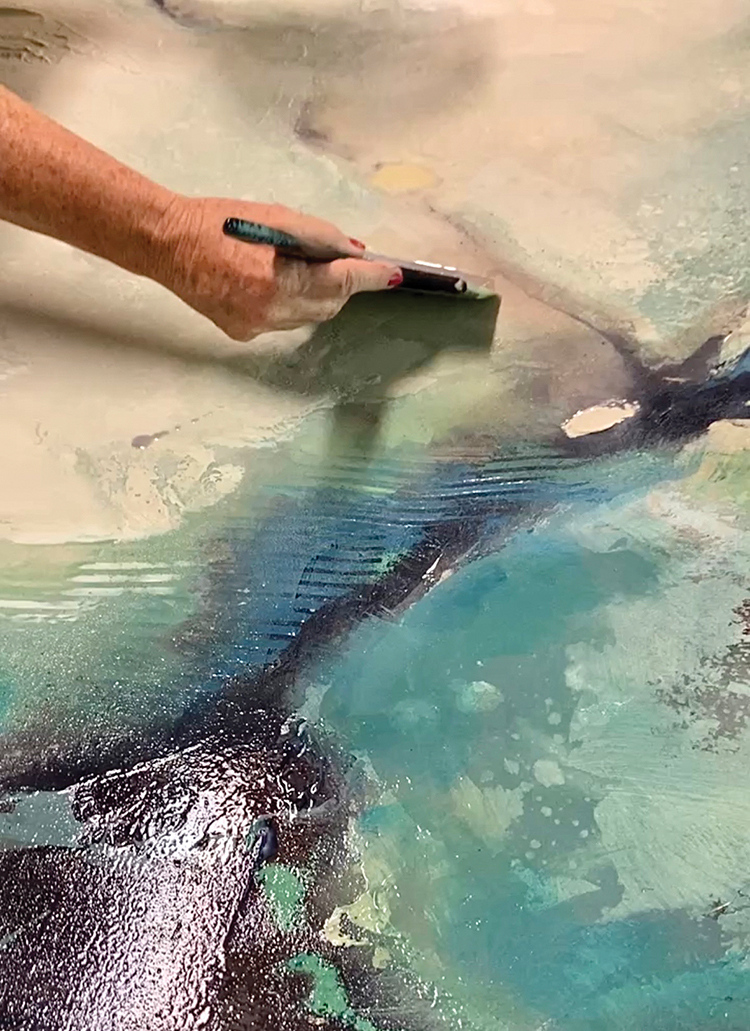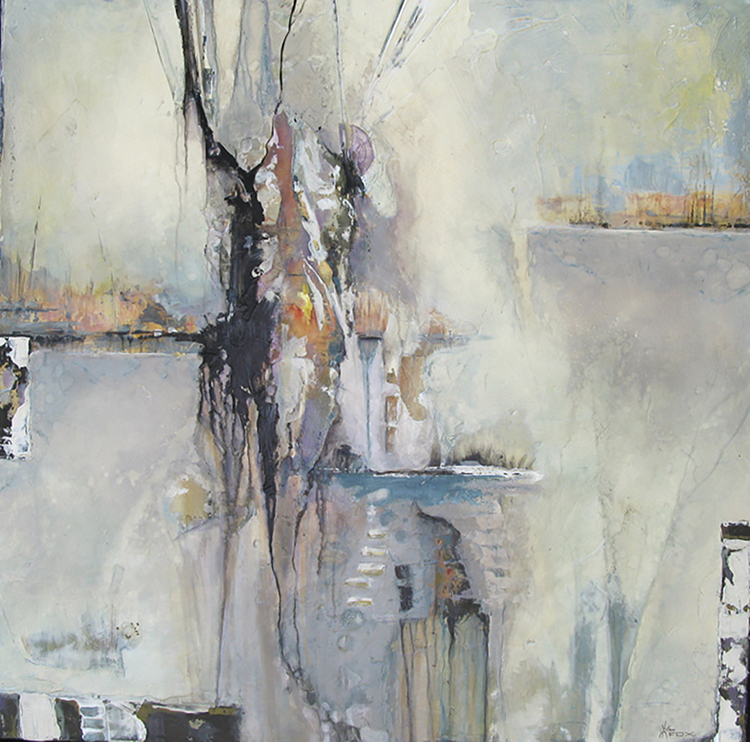
Journey
Raised on a farm near the Ohio River that powerfully cuts through Southern Illinois and Western Kentucky, I look back and realize that I am intrinsically drawn to rivers, creeks and streams. My journey has flowed like that as well. Just like water. It meandered, taking gentle turns and sometimes busting through rock if it had to. It was flowing down a path that was destined for me.
Almost 30 years ago, after studying decorative arts in Boston, my husband, four sons and I moved to Tennessee. I began practicing my newfound skills for prominent interior designers and their clients. This challenged me in new ways that expanded my capabilities.
Able to successfully mimic any style, I painted walls to look like aged limestone or marble, Venetian plaster, trompe l’oeil, furniture, decorative objects and murals. Whatever style or trickery a designer or client could dream up, I would make that happen with paint.
My stream gained swift momentum when I was asked to create a mural in the dining room of a magnificent, turn-of-the-century iconic home in Leiper’s Fork. It was to cover the entire room, from floor to 12-foot ceiling. This project was so daunting for me that I would go to the house, set up, lay my brushes out, stare at the four blank walls, choke back tears and go home. I did that for three weeks!

The clients just let me be, and I finally ended up running down to Leiper’s Creek behind the house. Crying and begging God for courage, I felt it well up within me. I marched up out of that creek to that formidable room, slapped my loaded brush against the wall and let it flow. It took six months to complete, successfully looking as though it was original to the home. It was quietly beautiful, and it was connected to the place. This place that I was falling in love with was Leiper’s Fork.
That client and visionary, Aubrey Preston, who had witnessed my can-do spirit, asked me to establish an art gallery in the village. I laughed out loud and said: “Aubrey! I’m a painter! I have never even balanced my own checkbook!”
He didn’t even wince and continued to persuade me to be a part of the movement toward building the arts in our village. I felt the current sweeping me gently and pushing me onward into depths I could never have even dreamed of. I knew that I was supposed to walk through those doors. I called the business Leiper’s Creek Gallery, named after the creek that runs through town.
The gallery was built on showcasing exceptional artists featuring an eclectic mix of art. The first two who signed on with me were of notable stature, one a master abstractionist and the other a plein-air painter of impressionistic landscapes. This “gift” helped me set the bar for additional accomplished artists to join the gallery in spite of the fact that we were considered to be out “in the sticks.” The quality of the art was such a surprise to stumble upon in a tiny village. It took years for that to grow, but it was meant to.
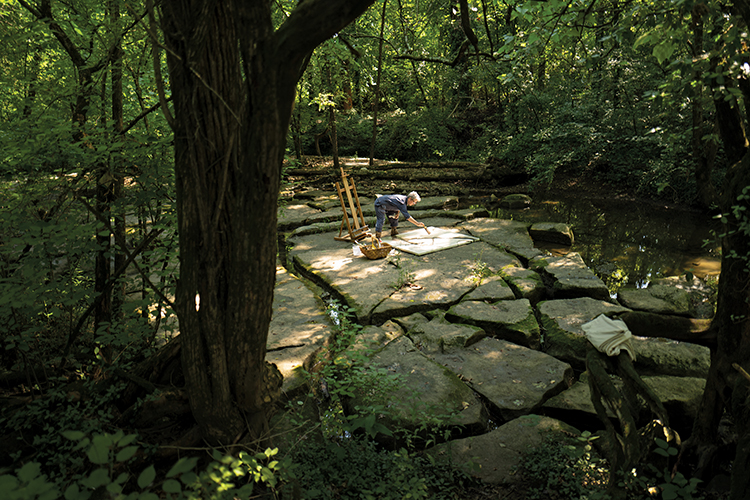
Painting en plein air (French for in the open air) became my passion in those first years of running the gallery. There was and still is a strong impressionist community of painters that enjoy our countryside and historic architecture. They are often seen painting in fields and streams along the country roads or in the village. Being outdoors and trekking through the fields and creeks was my fancy! I loved it! However, as my business grew, the more difficult it became to be a plein-air painter.
I eventually stopped painting. Pouring all of my energy into growing the gallery, I tried to be satisfied creatively by arranging the art, designing marketing pieces and flower arrangements, and all of those things that truly make a difference. The gallery was doing well, and the town was growing with more businesses and happily more galleries, but for me as an artist, my spirit was dimming.
I had to find a way to paint again.
A client had been in the gallery looking for a large painting to go above her fireplace. She showed me a picture of a landscape that she liked, but we didn’t have anything similar at the time. I thought: OK, that’s what I’ll do to break this dry spell. I will paint what she wants without telling her and then surprise her with it.
Having that personal challenge got me started, but it was only to discover that something was very wrong! The painting was coming along just fine, but I was MISERABLE. The very act of mixing color and juicy brushstrokes was not bringing the joy I had expected.
In a flash of clarity like a lightning bolt, I turned that large canvas upside down, scraped up a load of paint with my palette knife and instinctively began abstracting the imagery and layering color. My spirit cried out: It’s time! I have to dig deeper, and I will not stop until I find my own artistic purpose. Not driven by what someone else wants, but what God planted within me to create and share.
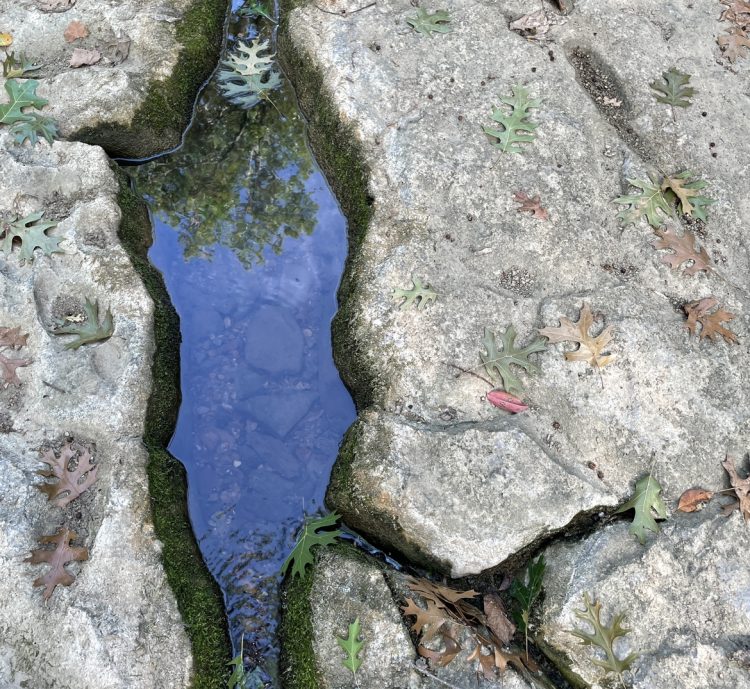
“Let the beauty we love be what we do. There are hundreds of ways to kneel and kiss the ground.”
— RUMI
My mentor, master abstractionist Anton Weiss, always said, “It’s not just about surface in abstract painting; it’s from here to there.”
He would put his hand on his chest “here” and extend it gently outward to “there.” I got that! One needs to enter in and walk around. Go deeper. Deep waters know great distances and challenges to arrive in calm peaceful waters. I could never have even dreamed up this life, and I will forever be grateful for the artistic satisfaction and joy that it brings me and is passed on to others.

Process
I thrive when I am immersed in water, leaves, moss, twigs and vines. Every morning, my dog, Abby, and I stomp all around the hillsides, woods and creeks, gathering inspiration, both artistically and spiritually.
As we walk the paths, my eye is eagerly searching out compositions and arrangements of shapes that I find dynamic. Sometimes that means looking really, really close like a child would do. Seeing the veins on a mottled leaf lying in moss or the patterns of water cutting through stone inspires composition, palette and textures.
“The essence of all beautiful art, all great art, is gratitude.”
— Friedrich Nietzsche
1. I have an idea of the purpose that I want the piece to have. It has been my experience to witness people viewing art in the gallery that I knew the artist painted with a particular emotion. They are moved and may not know why, but it’s in there. It’s like food that is cooked with love. It just tastes better.
2. My first marks are to break the white of the canvas, maybe a word that describes a sentiment. In this painting, it was a blessing written out knowing it would never be visible: “You shall be blessed when you come in, and you shall be blessed when you go out.” — Deuteronomy 28:6
3. Since my inspiration comes from treasures I find in nature, it helps me to actually be there. I take the canvas to the location with me, lay down the “bones” of the piece in black and warm brown acrylic paint. This way, I feel connected and free to make gestures that are instinctive, loose and painterly. My goal is to let organic surprises occur by using a variety of tools for mark-making and spray down with liquid to disperse.
4. Back in studio, I study what happened in the creek (hopefully a fresh exciting composition) and start laying down transparent colors using palette knives, brushes or cardboard pieces, but nothing too precious. (Precious tools tend to make precious marks.) I am mindful of color harmony and the division of shapes, edges, values and loose mark-making that drives the viewer around inside the painting. Pattern against rest is important as well.
5. By this time, I usually have sections of the work that I don’t want anymore, and I use plaster to change it. I like letting the under painting peak up through the plaster to create more depth and texture. I keep layering color in a variety of ways and finesse the final magical touches. When I feel harmony and that what I set out to express is there, I am finished.
6. Time to sign the painting and put thoughtful effort into the title. This, too, is another way to connect with the viewer and cannot be underestimated. This commissioned painting was titled, and the blessing written on the canvas was for a woman who had lost her husband. The title is “The Perseverance of Peace.”
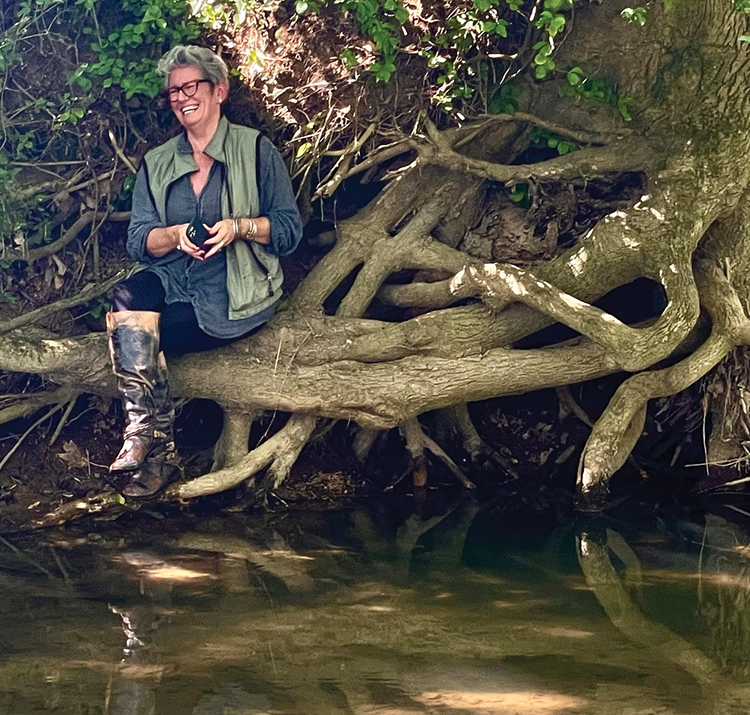
“It’s the artists of the world, the feelers and thinkers, who will ultimately save us, who can articulate, educate, defy, insist, sing and shout the big dreams.”
— Leonard Bernstein

Journey
Raised on a farm near the Ohio River that powerfully cuts through Southern Illinois and Western Kentucky, I look back and realize that I am intrinsically drawn to rivers, creeks and streams. My journey has flowed like that as well. Just like water. It meandered, taking gentle turns and sometimes busting through rock if it had to. It was flowing down a path that was destined for me.
Almost 30 years ago, after studying decorative arts in Boston, my husband, four sons and I moved to Tennessee. I began practicing my newfound skills for prominent interior designers and their clients. This challenged me in new ways that expanded my capabilities.
Able to successfully mimic any style, I painted walls to look like aged limestone or marble, Venetian plaster, trompe l’oeil, furniture, decorative objects and murals. Whatever style or trickery a designer or client could dream up, I would make that happen with paint.
My stream gained swift momentum when I was asked to create a mural in the dining room of a magnificent, turn-of-the-century iconic home in Leiper’s Fork. It was to cover the entire room, from floor to 12-foot ceiling. This project was so daunting for me that I would go to the house, set up, lay my brushes out, stare at the four blank walls, choke back tears and go home. I did that for three weeks!

The clients just let me be, and I finally ended up running down to Leiper’s Creek behind the house. Crying and begging God for courage, I felt it well up within me. I marched up out of that creek to that formidable room, slapped my loaded brush against the wall and let it flow. It took six months to complete, successfully looking as though it was original to the home. It was quietly beautiful, and it was connected to the place. This place that I was falling in love with was Leiper’s Fork.
That client and visionary, Aubrey Preston, who had witnessed my can-do spirit, asked me to establish an art gallery in the village. I laughed out loud and said: “Aubrey! I’m a painter! I have never even balanced my own checkbook!”
He didn’t even wince and continued to persuade me to be a part of the movement toward building the arts in our village. I felt the current sweeping me gently and pushing me onward into depths I could never have even dreamed of. I knew that I was supposed to walk through those doors. I called the business Leiper’s Creek Gallery, named after the creek that runs through town.
The gallery was built on showcasing exceptional artists featuring an eclectic mix of art. The first two who signed on with me were of notable stature, one a master abstractionist and the other a plein-air painter of impressionistic landscapes. This “gift” helped me set the bar for additional accomplished artists to join the gallery in spite of the fact that we were considered to be out “in the sticks.” The quality of the art was such a surprise to stumble upon in a tiny village. It took years for that to grow, but it was meant to.

Painting en plein air (French for in the open air) became my passion in those first years of running the gallery. There was and still is a strong impressionist community of painters that enjoy our countryside and historic architecture. They are often seen painting in fields and streams along the country roads or in the village. Being outdoors and trekking through the fields and creeks was my fancy! I loved it! However, as my business grew, the more difficult it became to be a plein-air painter.
I eventually stopped painting. Pouring all of my energy into growing the gallery, I tried to be satisfied creatively by arranging the art, designing marketing pieces and flower arrangements, and all of those things that truly make a difference. The gallery was doing well, and the town was growing with more businesses and happily more galleries, but for me as an artist, my spirit was dimming.
I had to find a way to paint again.
A client had been in the gallery looking for a large painting to go above her fireplace. She showed me a picture of a landscape that she liked, but we didn’t have anything similar at the time. I thought: OK, that’s what I’ll do to break this dry spell. I will paint what she wants without telling her and then surprise her with it.
Having that personal challenge got me started, but it was only to discover that something was very wrong! The painting was coming along just fine, but I was MISERABLE. The very act of mixing color and juicy brushstrokes was not bringing the joy I had expected.
In a flash of clarity like a lightning bolt, I turned that large canvas upside down, scraped up a load of paint with my palette knife and instinctively began abstracting the imagery and layering color. My spirit cried out: It’s time! I have to dig deeper, and I will not stop until I find my own artistic purpose. Not driven by what someone else wants, but what God planted within me to create and share.

“Let the beauty we love be what we do. There are hundreds of ways to kneel and kiss the ground.”
— RUMI
My mentor, master abstractionist Anton Weiss, always said, “It’s not just about surface in abstract painting; it’s from here to there.”
He would put his hand on his chest “here” and extend it gently outward to “there.” I got that! One needs to enter in and walk around. Go deeper. Deep waters know great distances and challenges to arrive in calm peaceful waters. I could never have even dreamed up this life, and I will forever be grateful for the artistic satisfaction and joy that it brings me and is passed on to others.

Process
I thrive when I am immersed in water, leaves, moss, twigs and vines. Every morning, my dog, Abby, and I stomp all around the hillsides, woods and creeks, gathering inspiration, both artistically and spiritually.
As we walk the paths, my eye is eagerly searching out compositions and arrangements of shapes that I find dynamic. Sometimes that means looking really, really close like a child would do. Seeing the veins on a mottled leaf lying in moss or the patterns of water cutting through stone inspires composition, palette and textures.
“The essence of all beautiful art, all great art, is gratitude.”
— Friedrich Nietzsche
1. I have an idea of the purpose that I want the piece to have. It has been my experience to witness people viewing art in the gallery that I knew the artist painted with a particular emotion. They are moved and may not know why, but it’s in there. It’s like food that is cooked with love. It just tastes better.
2. My first marks are to break the white of the canvas, maybe a word that describes a sentiment. In this painting, it was a blessing written out knowing it would never be visible: “You shall be blessed when you come in, and you shall be blessed when you go out.” — Deuteronomy 28:6
3. Since my inspiration comes from treasures I find in nature, it helps me to actually be there. I take the canvas to the location with me, lay down the “bones” of the piece in black and warm brown acrylic paint. This way, I feel connected and free to make gestures that are instinctive, loose and painterly. My goal is to let organic surprises occur by using a variety of tools for mark-making and spray down with liquid to disperse.
4. Back in studio, I study what happened in the creek (hopefully a fresh exciting composition) and start laying down transparent colors using palette knives, brushes or cardboard pieces, but nothing too precious. (Precious tools tend to make precious marks.) I am mindful of color harmony and the division of shapes, edges, values and loose mark-making that drives the viewer around inside the painting. Pattern against rest is important as well.
5. By this time, I usually have sections of the work that I don’t want anymore, and I use plaster to change it. I like letting the under painting peak up through the plaster to create more depth and texture. I keep layering color in a variety of ways and finesse the final magical touches. When I feel harmony and that what I set out to express is there, I am finished.
6. Time to sign the painting and put thoughtful effort into the title. This, too, is another way to connect with the viewer and cannot be underestimated. This commissioned painting was titled, and the blessing written on the canvas was for a woman who had lost her husband. The title is “The Perseverance of Peace.”

“It’s the artists of the world, the feelers and thinkers, who will ultimately save us, who can articulate, educate, defy, insist, sing and shout the big dreams.”
— Leonard Bernstein







